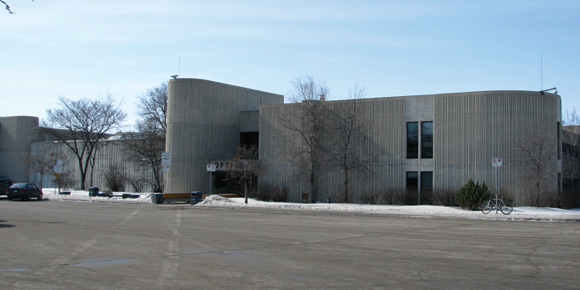Fort Rouge was established as a trading post by Pierre Gaultier de Varennes et de La Vérendrye in 1738. It is considered to be the earliest recorded structure built by settlers on what is now the city of Winnipeg. The exact location of the fort is unknown, only that it was near the confluence of the Red and Assiniboine rivers.
The Park Theatre
698 Osborne Street
The Park Theatre opened to little fanfare in 1914 or 1915 as a combination live theatre and moving picture house.
Rudolph and Mary Besler took over the business in 1936 and hired local architects Green, Blankstein and Russell to carry out a $20,000 renovation and expansion. The work included widening the building by nearly eight metres and building a new façade. Inside, the seating, air filtration system and electrical system were replaced.
The “new” Park Theatre reopened on August 31, 1936 with the Fred Astaire / Ginger Rogers film Follow the Fleet.
For the next couple of decades, the Park showed movies on a regular basis but to help pay the bills was rented out for church services, live concerts and public speaking engagements.
Most of Winnipeg’s neighbourhood theatres closed or were converted to other uses in the 1950s as television became the public’s entertainment medium of choice. The Park bucked that trend.
In 1965, the Beslers retired and sold the building to Odeon Cinemas which continued to show movies there until 1988.
Except for a brief revival as a live venue in the mid-1990s the theatre sat vacant for most of the next seventeen years.
In 2005, Erick and Melanie Casselman bought the property and spent over $350,00 to convert it into a movie rental store, café and theatre. Over time, the store disappeared, the café was scaled back, and the Park Theatre evolved into one of the city’s premiere live music venues.
Winnipeg Transit Fort Rouge Garage
421 Osborne Street
Prior to 1953, Winnipeg’s public transportation system was run by a private entity. That year, the provincial government bought out the Winnipeg Electric Company and the Greater Winnipeg Transit Commission, forerunner to Winnipeg Transit, was created.
The commission’s first major act was to shut down the city’s ageing streetcar system in 1955 in favour of an expanded fleet of diesel buses and electric trolleys. A decade later, it was announced that trolleys, too, would be phased out by the end of the 1960s.
To prepare for Transit’s all-bus future its main garage located at Main Street and Assiniboine Avenue, which was custom-built decades earlier to service streetcars, had to be replaced.
In 1966, the city and CN Rail, owner of the adjacent Hotel Fort Garry, negotiated a land swap.
CN received a large section of the land that the old garage stood on for use as parking or a possible hotel expansion. In exchange, the city got a 23-acre site carved out of the edge of CN’s Fort Rouge Yards on which to build its new garage.
The city turned to architects Waisman Ross-Blankstein Coop Gillmor Hanna, now known as Number Ten, to design the $6.5 million facility. The firm was receiving national attention at the time for its work, which included such landmark buildings as the Winnipeg Art Gallery and Manitoba Theatre Centre.
The site’s main building is 185,000 square feet in size and serves two purposes. To the north is Transit’s two-storey administrative office wing while the southern portion is a vast maintenance garage.
It is a prime example of “brutalist” style architecture with its narrow windows, recessed entryway and cast-in-place concrete walls.
The second building is a drive-through garage that can hold 480 buses and Transit’s support vehicles. It also includes washing and refueling areas.
The Fort Rouge Garage, as it is commonly known, is in the midst of a multi-year modernization plan. Recently, a new garage was built to accommodate Transit’s growing bus fleet and plans are underway for the addition of a new maintenance facility.
Former Winnipeg Electric Company Substation
265 Osborne Street
Sometimes a building is not what it seems and that is the case with 265 Osborne Street at Jessie Avenue.
In 1938, the Winnipeg Electric Company introduced the first electric trolley buses to the streets of Winnipeg. Trolleys were a hybrid between streetcars and buses as they ran off electricity delivered through overhead lines but instead of rails they used a rubber-tired bus chassis which gave them the ability to change lanes.
In order to power a trolley bus line there had to be a direct current substation, also called a rectifier, somewhere along the route. This was tricky to insert into a residential neighbourhood as homeowners did not want to have an industrial site in their midst.
To overcome this opposition the Electric Company disguised the rectifiers so that they fit in with their surrounding neighbourhood. (Other utilities, such as Winnipeg Hydro and MTS, had to do the same thing and there are still a few industrial sites masquerading as homes or small commercial buildings around the city.)
This 1,166 square foot substation was built in 1947 and is what the Electric Company referred to as its “Georgian Library” style facade. The rectifier’s giant heat exchangers were disguised as a pair of chimneys. With its real windows and appropriate landscaping, it was impossible to tell from the outside what the interior held.
When trolley bus service ended in 1970 the mechanical equipment was removed and the building was converted into offices for the city’s Fort Rouge Community Committee. From the late 1980s to 2014, it was home to the General Council of Winnipeg Community Clubs.
In 2014, the land was sold to the developer of the neighbouring Osborne Place mixed-use development which is now in the final stages of construction. The building will eventually be demolished to allow for parking and the widening of Jessie Avenue.
Christian Cassidy writes about local history on his blog, West End Dumplings.



